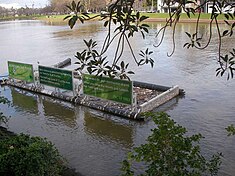Ancient cultures
e major forms of pollution are listed below along with the particular pollutants relevant to each of them:- Air pollution:- the release of chemicals and particulates into the atmosphere. Common gaseous pollutants include carbon monoxide, sulfur dioxide, chlorofluorocarbons (CFCs) and nitrogen oxides produced by industry and motor vehicles. Photochemical ozone and smog are created as nitrogen oxides and hydrocarbons react to sunlight. Particulate matter, or fine dust is characterized by their micrometre size PM10 to PM2.5.
- Light pollution:- includes light trespass, over-illumination and astronomical interference.
- Littering:- the criminal throwing of inappropriate man-made objects, unremoved, onto public and private properties.
- Noise pollution:- which encompasses roadway noise, aircraft noise, industrial noise as well as high-intensity sonar.
- Soil contamination occurs when chemicals are released intentionally, by spill or underground leakage. Among the most significant soil contaminants are hydrocarbons, heavy metals, MTBE,[9] herbicides, pesticides and chlorinated hydrocarbons.
- Radioactive contamination, resulting from 20th century activities in atomic physics, such as nuclear power generation and nuclear weapons research, manufacture and deployment. (See alpha emitters and actinides in the environment.)
- Thermal pollution, is a temperature change in natural water bodies caused by human influence, such as use of water as coolant in a power plant.
- Visual pollution, which can refer to the presence of overhead power lines, motorway billboards, scarred landforms (as from strip mining), open storage of trash or municipal solid waste.
- Water pollution, by the discharge of wastewater from commercial and industrial waste (intentionally or through spills) into surface waters; discharges of untreated domestic sewage, and chemical contaminants, such as chlorine, from treated sewage; release of waste and contaminants into surface runoff flowing to surface waters (including urban runoff and agricultural runoff, which may contain chemical fertilizers and pesticides); waste disposal and leaching into groundwater; eutrophication and littering.
[edit] Pollutants
Main article: Pollutant
A pollutant is a waste material that pollutes air, water or soil. Three factors determine the severity of a pollutant: its chemical nature, the concentration and the persistence.[edit] Sources and causes
Air pollution comes from both natural and man made sources. Though globally man made pollutants from combustion, construction, mining, agriculture and warfare are increasingly significant in the air pollution equation.[10]Motor vehicle emissions are one of the leading causes of air pollution.[11][12][13] China, United States, Russia, Mexico, and Japan are the world leaders in air pollution emissions. Principal stationary pollution sources include chemical plants, coal-fired power plants, oil refineries,[14] petrochemical plants, nuclear waste disposal activity, incinerators, large livestock farms (dairy cows, pigs, poultry, etc.), PVC factories, metals production factories, plastics factories, and other heavy industry. Agricultural air pollution comes from contemporary practices which include clear felling and burning of natural vegetation as well as spraying of pesticides and herbicides[15]
About 400 million metric tons of hazardous wastes are generated each year.[16] The United States alone produces about 250 million metric tons.[17] Americans constitute less than 5% of the world's population, but produce roughly 25% of the world’s CO2,[18] and generate approximately 30% of world’s waste.[19][20] In 2007, China has overtaken the United States as the world's biggest producer of CO2,[21] while still far behind based on per capita pollution - ranked 78th among the world's nation. [22]
In February 2007, a report by the Intergovernmental Panel on Climate Change (IPCC), representing the work of 2,500 scientists, economists, and policymakers from more than 120 countries, said that humans have been the primary cause of global warming since 1950. Humans have ways to cut greenhouse gas emissions and avoid the consequences of global warming, a major climate report concluded. But in order to change the climate, the transition from fossil fuels like coal and oil needs to occur within decades, according to the final report this year from the UN's Intergovernmental Panel on Climate Change (IPCC).[23]
Some of the more common soil contaminants are chlorinated hydrocarbons (CFH), heavy metals (such as chromium, cadmium–found in rechargeable batteries, and lead–found in lead paint, aviation fuel and still in some countries, gasoline), MTBE, zinc, arsenic and benzene. In 2001 a series of press reports culminating in a book called Fateful Harvest unveiled a widespread practice of recycling industrial byproducts into fertilizer, resulting in the contamination of the soil with various metals. Ordinary municipal landfills are the source of many chemical substances entering the soil environment (and often groundwater), emanating from the wide variety of refuse accepted, especially substances illegally discarded there, or from pre-1970 landfills that may have been subject to little control in the U.S. or EU. There have also been some unusual releases of polychlorinated dibenzodioxins, commonly called dioxins for simplicity, such as TCDD.[24]
Pollution can also be the consequence of a natural disaster. For example, hurricanes often involve water contamination from sewage, and petrochemical spills from ruptured boats or automobiles. Larger scale and environmental damage is not uncommon when coastal oil rigs or refineries are involved. Some sources of pollution, such as nuclear power plants or oil tankers, can produce widespread and potentially hazardous releases when accidents occur.
In the case of noise pollution the dominant source class is the motor vehicle, producing about ninety percent of all unwanted noise worldwide.
[edit] Effects
[edit] Human health
Adverse air quality can kill many organisms including humans. Ozone pollution can cause respiratory disease, cardiovascular disease, throat inflammation, chest pain, and congestion. Water pollution causes approximately 14,000 deaths per day, mostly due to contamination of drinking water by untreated sewage in developing countries. An estimated 700 million Indians have no access to a proper toilet, and 1,000 Indian children die of diarrhoeal sickness every day.[28] Nearly 500 million Chinese lack access to safe drinking water.[29] 656,000 people die prematurely each year in China because of air pollution. In India, air pollution is believed to cause 527,700 fatalities a year.[30] Studies have estimated that the number of people killed annually in the US could be over 50,000.[31]Oil spills can cause skin irritations and rashes. Noise pollution induces hearing loss, high blood pressure, stress, and sleep disturbance. Mercury has been linked to developmental deficits in children and neurologic symptoms. Older people are majorly exposed to diseases induced by air pollution. Those with heart or lung disorders are under additional risk. Children and infants are also at serious risk. Lead and other heavy metals have been shown to cause neurological problems. Chemical and radioactive substances can cause cancer and as well as birth defects.
[edit] Environment
Pollution has been found to be present widely in the environment. There are a number of effects of this:- Biomagnification describes situations where toxins (such as heavy metals) may pass through trophic levels, becoming exponentially more concentrated in the process.
- Carbon dioxide emissions cause ocean acidification, the ongoing decrease in the pH of the Earth's oceans as CO2 becomes dissolved.
- The emission of greenhouse gases leads to global warming which affects ecosystems in many ways.
- Invasive species can out compete native species and reduce biodiversity. Invasive plants can contribute debris and biomolecules (allelopathy) that can alter soil and chemical compositions of an environment, often reducing native species competitiveness.
- Nitrogen oxides are removed from the air by rain and fertilise land which can change the species composition of ecosystems.
- Smog and haze can reduce the amount of sunlight received by plants to carry out photosynthesis and leads to the production of tropospheric ozone which damages plants.
- Soil can become infertile and unsuitable for plants. This will affect other organisms in the food web.
- Sulfur dioxide and nitrogen oxides can cause acid rain which lowers the pH value of soil.
[edit] Environmental health information
The Toxicology and Environmental Health Information Program (TEHIP)[32] at the United States National Library of Medicine (NLM) maintains a comprehensive toxicology and environmental health web site that includes access to resources produced by TEHIP and by other government agencies and organizations. This web site includes links to databases, bibliographies, tutorials, and other scientific and consumer-oriented resources. TEHIP also is responsible for the Toxicology Data Network (TOXNET®)[33] an integrated system of toxicology and environmental health databases that are available free of charge on the web.TOXMAP is a Geographic Information System (GIS) that is part of TOXNET. TOXMAP uses maps of the United States to help users visually explore data from the United States Environmental Protection Agency's (EPA) Toxics Release Inventory and Superfund Basic Research Programs.
[edit] Regulation and monitoring
Main article: Regulation and monitoring of pollution
To protect the environment from the adverse effects of pollution, many nations worldwide have enacted legislation to regulate various types of pollution as well as to mitigate the adverse effects of pollution.[edit] Pollution control

Gas nozzle with vapor recovery
[edit] Practices
[edit] Pollution control devices
- Dust collection systems
- Scrubbers
- Sewage treatment
- Sedimentation (Primary treatment)
- Activated sludge biotreaters (Secondary treatment; also used for industrial wastewater)
- Aerated lagoons
- Constructed wetlands (also used for urban runoff)
- Industrial wastewater treatment
- Vapor recovery systems












No comments:
Post a Comment